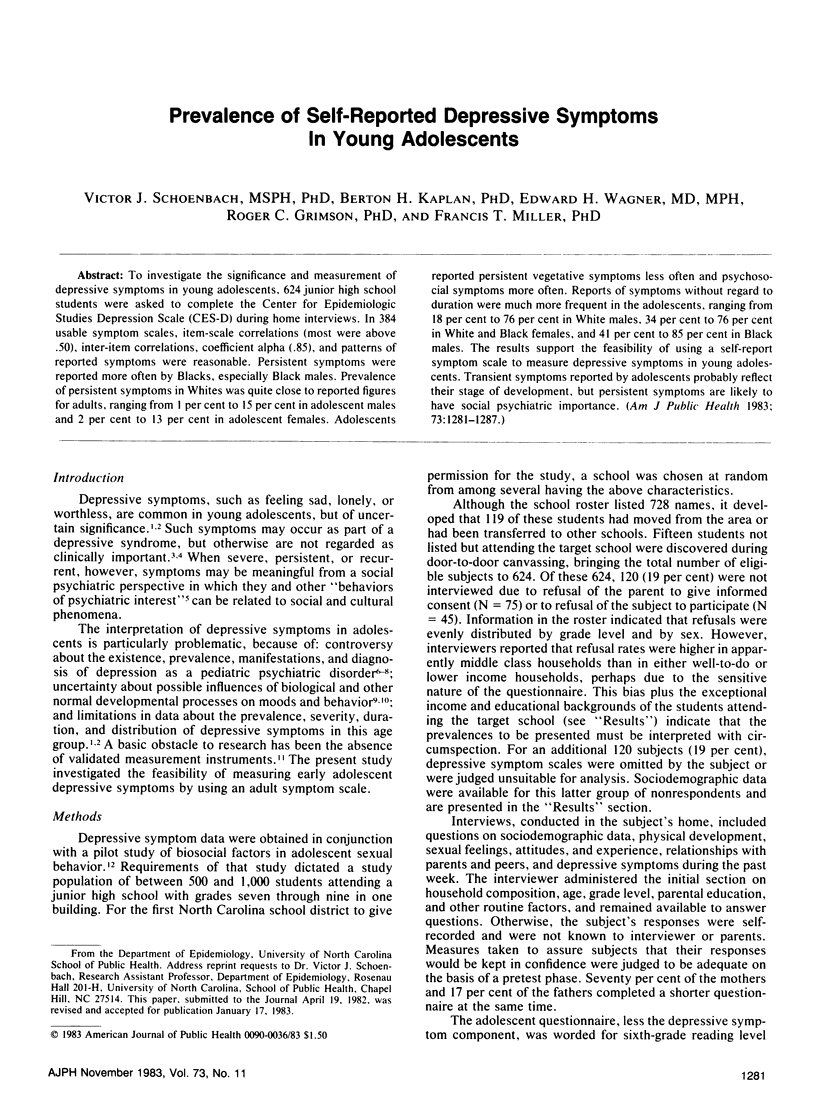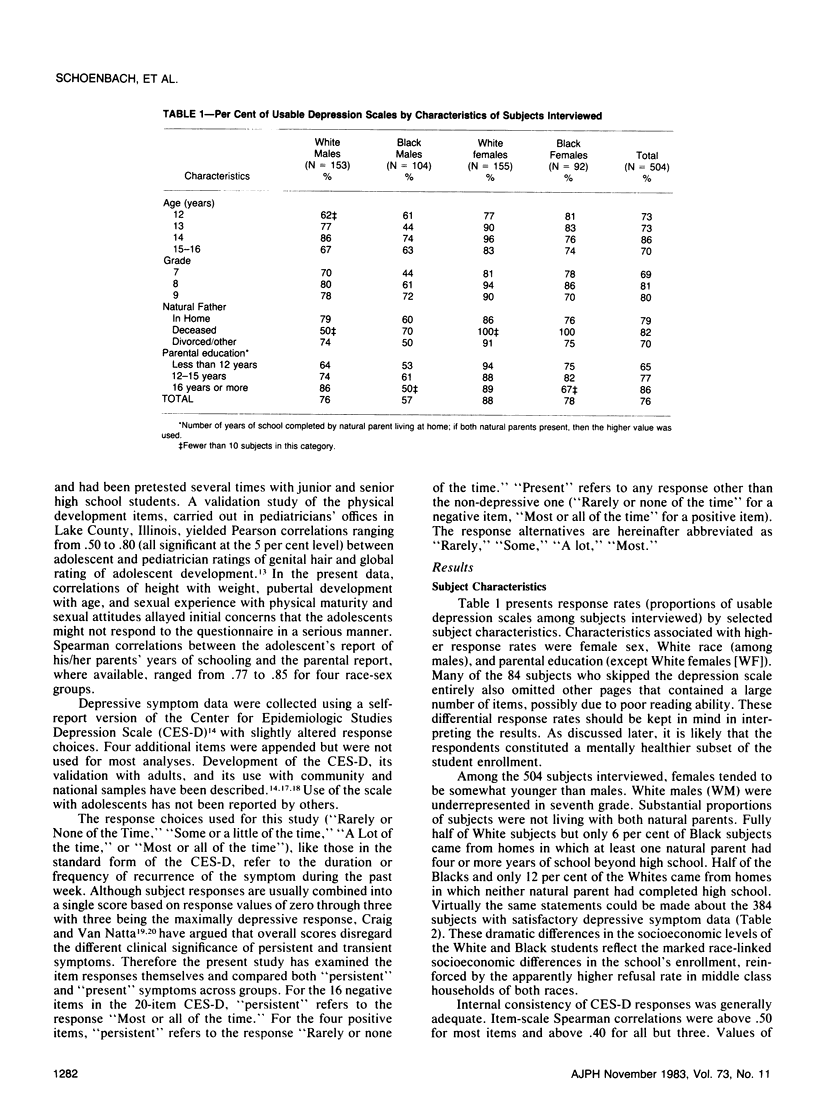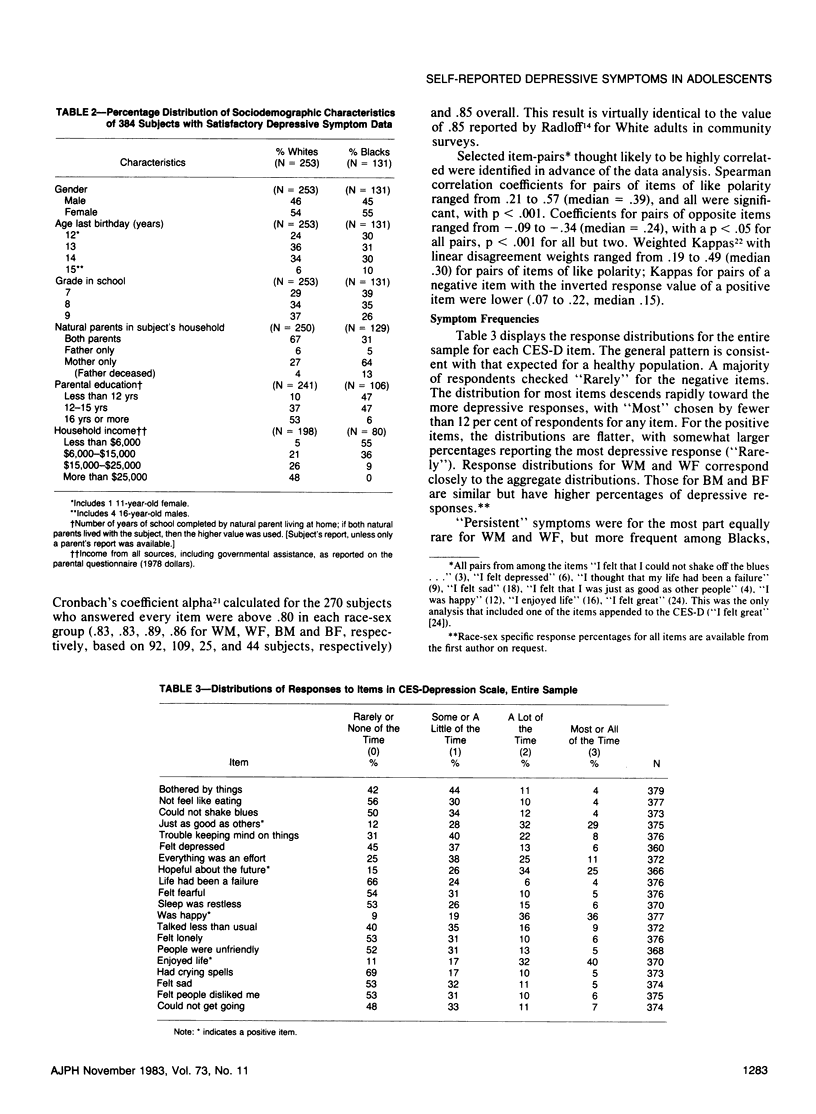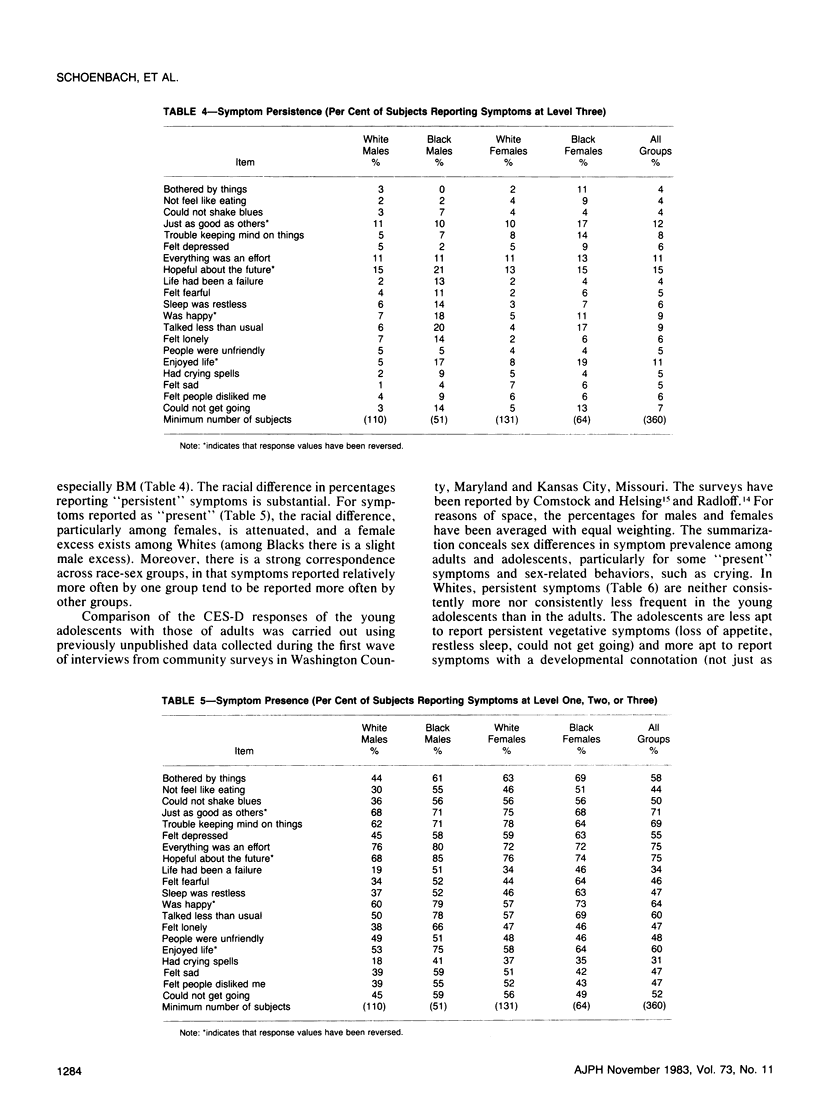Abstract
To investigate the significance and measurement of depressive symptoms in young adolescents, 624 junior high school students were asked to complete the Center for Epidemiologic Studies Depression Scale (CES-D) during home interviews. In 384 usable symptom scales, item-scale correlations (most were above .50), inter-item correlations, coefficient alpha (.85), and patterns of reported symptoms were reasonable. Persistent symptoms were reported more often by Blacks, especially Black males. Prevalence of persistent symptoms in Whites was quite close to reported figures for adults, ranging from 1 per cent to 15 per cent in adolescent males and 2 per cent to 13 per cent in adolescent females. Adolescents reported persistent vegetative symptoms less often and psychosocial symptoms more often. Reports of symptoms without regard to duration were much more frequent in the adolescents, ranging from 18 per cent to 76 per cent in White males, 34 per cent to 76 per cent in White and Black females, and 41 per cent to 85 per cent in Black males. The results support the feasibility of using a self-report symptom scale to measure depressive symptoms in young adolescents. Transient symptoms reported by adolescents probably reflect their stage of development, but persistent symptoms are likely to have social psychiatric importance.
Full text
PDF






Selected References
These references are in PubMed. This may not be the complete list of references from this article.
- Akiskal H. S., McKinney W. T., Jr Overview of recent research in depression. Integration of ten conceptual models into a comprehensive clinical frame. Arch Gen Psychiatry. 1975 Mar;32(3):285–305. doi: 10.1001/archpsyc.1975.01760210019001. [DOI] [PubMed] [Google Scholar]
- Comstock G. W., Helsing K. J. Symptoms of depression in two communities. Psychol Med. 1976 Nov;6(4):551–563. doi: 10.1017/s0033291700018171. [DOI] [PubMed] [Google Scholar]
- Craig T. J., Van Natta P. A. Influence of demographic characteristics on two measures of depressive symptoms: the relation of prevalence and persistence of symptoms with sex, age, education, and marital status. Arch Gen Psychiatry. 1979 Feb;36(2):149–154. doi: 10.1001/archpsyc.1979.01780020039003. [DOI] [PubMed] [Google Scholar]
- Craig T. J., Van Natta P. A. Presence and persistence of depressive symptoms in patient and community populations. Am J Psychiatry. 1976 Dec;133(12):1426–1429. doi: 10.1176/ajp.133.12.1426. [DOI] [PubMed] [Google Scholar]
- Eaton W. W., Kessler L. G. Rates of symptoms of depression in a national sample. Am J Epidemiol. 1981 Oct;114(4):528–538. doi: 10.1093/oxfordjournals.aje.a113218. [DOI] [PubMed] [Google Scholar]
- Frerichs R. R., Aneshensel C. S., Clark V. A. Prevalence of depression in Los Angeles County. Am J Epidemiol. 1981 Jun;113(6):691–699. doi: 10.1093/oxfordjournals.aje.a113149. [DOI] [PubMed] [Google Scholar]
- Graham P. Depression in pre-pubertal children. Dev Med Child Neurol. 1974 Jun;16(3):340–349. doi: 10.1111/j.1469-8749.1974.tb03345.x. [DOI] [PubMed] [Google Scholar]
- Hankin J. R., Locke B. Z. The persistence of depressive symptomatology among prepaid group practice enrollees: an exploratory study. Am J Public Health. 1982 Sep;72(9):1000–1007. doi: 10.2105/ajph.72.9.1000. [DOI] [PMC free article] [PubMed] [Google Scholar]
- Hays S. E. Strategies for psychoendocrine studies of puberty. Psychoneuroendocrinology. 1978 Jan;3(1):1–15. doi: 10.1016/0306-4530(78)90037-9. [DOI] [PubMed] [Google Scholar]
- Kashani J., Simonds J. F. The incidence of depression in children. Am J Psychiatry. 1979 Sep;136(9):1203–1205. doi: 10.1176/ajp.136.9.1203. [DOI] [PubMed] [Google Scholar]
- Lefkowitz M. M., Burton N. Childhood depression: a critique of the concept. Psychol Bull. 1978 Jul;85(4):716–726. [PubMed] [Google Scholar]
- Leslie S. A. Psychiatric disorder in the young adolescents of an industrial town. Br J Psychiatry. 1974 Aug;125(0):113–124. doi: 10.1192/bjp.125.2.113. [DOI] [PubMed] [Google Scholar]
- Rutter M., Graham P., Chadwick O. F., Yule W. Adolescent turmoil: fact or fiction? J Child Psychol Psychiatry. 1976 Jan;17(1):35–56. doi: 10.1111/j.1469-7610.1976.tb00372.x. [DOI] [PubMed] [Google Scholar]
- Schoenbach V. J., Kaplan B. H., Grimson R. C., Wagner E. H. Use of a symptom scale to study the prevalence of a depressive syndrome in young adolescents. Am J Epidemiol. 1982 Nov;116(5):791–800. doi: 10.1093/oxfordjournals.aje.a113469. [DOI] [PubMed] [Google Scholar]
- Spitzer R. L., Endicott J., Robins E. Research diagnostic criteria: rationale and reliability. Arch Gen Psychiatry. 1978 Jun;35(6):773–782. doi: 10.1001/archpsyc.1978.01770300115013. [DOI] [PubMed] [Google Scholar]
- Warheit G. J., Holzer C. E., 3rd, Schwab J. J. An analysis of social class and racial differences in depressive symptomatology: a community study. J Health Soc Behav. 1973 Dec;14(4):291–299. [PubMed] [Google Scholar]
- Weissman M. M., Sholomskas D., Pottenger M., Prusoff B. A., Locke B. Z. Assessing depressive symptoms in five psychiatric populations: a validation study. Am J Epidemiol. 1977 Sep;106(3):203–214. doi: 10.1093/oxfordjournals.aje.a112455. [DOI] [PubMed] [Google Scholar]


